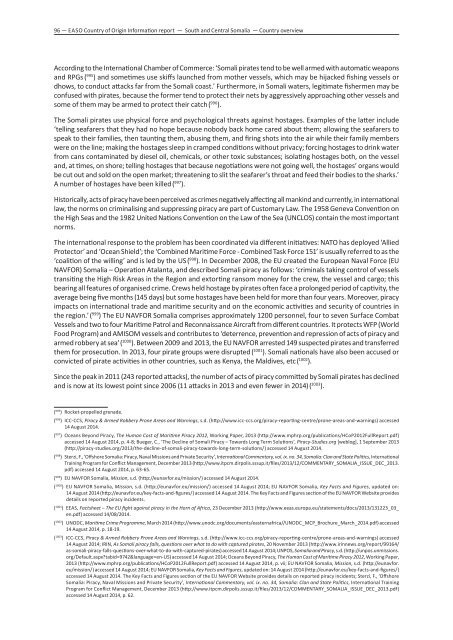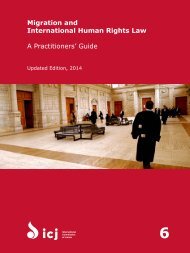Create successful ePaper yourself
Turn your PDF publications into a flip-book with our unique Google optimized e-Paper software.
96 — EASO Country of Origin Information report — South and Central <strong>Somalia</strong> — Country overview<br />
According to the International Chamber of Commerce: ‘Somali pirates tend to be well armed with automatic weapons<br />
and RPGs ( 995 ) and sometimes use skiffs launched from mother vessels, which may be hijacked fishing vessels or<br />
dhows, to conduct attacks far from the Somali coast.’ Furthermore, in Somali waters, legitimate fishermen may be<br />
confused with pirates, because the former tend to protect their nets by aggressively approaching other vessels and<br />
some of them may be armed to protect their catch ( 996 ).<br />
The Somali pirates use physical force and psychological threats against hostages. Examples of the latter include<br />
‘telling seafarers that they had no hope because nobody back home cared about them; allowing the seafarers to<br />
speak to their families, then taunting them, abusing them, and firing shots into the air while their family members<br />
were on the line; making the hostages sleep in cramped conditions without privacy; forcing hostages to drink water<br />
from cans contaminated by diesel oil, chemicals, or other toxic substances; isolating hostages both, on the vessel<br />
and, at times, on shore; telling hostages that because negotiations were not going well, the hostages’ organs would<br />
be cut out and sold on the open market; threatening to slit the seafarer’s throat and feed their bodies to the sharks.’<br />
A number of hostages have been killed ( 997 ).<br />
Historically, acts of piracy have been perceived as crimes negatively affecting all mankind and currently, in international<br />
law, the norms on criminalising and suppressing piracy are part of Customary Law. The 1958 Geneva Convention on<br />
the High Seas and the 1982 United Nations Convention on the Law of the Sea (UNCLOS) contain the most important<br />
norms.<br />
The international response to the problem has been coordinated via different initiatives: NATO has deployed ‘Allied<br />
Protector’ and ‘Ocean Shield’; the ‘Combined Maritime Force - Combined Task Force 151’ is usually referred to as the<br />
‘coalition of the willing’ and is led by the US ( 998 ). In December 2008, the EU created the European Naval Force (EU<br />
NAVFOR) <strong>Somalia</strong> – Operation Atalanta, and described Somali piracy as follows: ‘criminals taking control of vessels<br />
transiting the High Risk Areas in the Region and extorting ransom money for the crew, the vessel and cargo; this<br />
bearing all features of organised crime. Crews held hostage by pirates often face a prolonged period of captivity, the<br />
average being five months (145 days) but some hostages have been held for more than four years. Moreover, piracy<br />
impacts on international trade and maritime security and on the economic activities and security of countries in<br />
the region.’ ( 999 ) The EU NAVFOR <strong>Somalia</strong> comprises approximately 1200 personnel, four to seven Surface Combat<br />
Vessels and two to four Maritime Patrol and Reconnaissance Aircraft from different countries. It protects WFP (World<br />
Food Program) and AMISOM vessels and contributes to ‘deterrence, prevention and repression of acts of piracy and<br />
armed robbery at sea’ ( 1000 ). Between 2009 and 2013, the EU NAVFOR arrested 149 suspected pirates and transferred<br />
them for prosecution. In 2013, four pirate groups were disrupted ( 1001 ). Somali nationals have also been accused or<br />
convicted of pirate activities in other countries, such as Kenya, the Maldives, etc ( 1002 ).<br />
Since the peak in 2011 (243 reported attacks), the number of acts of piracy committed by Somali pirates has declined<br />
and is now at its lowest point since 2006 (11 attacks in 2013 and even fewer in 2014) ( 1003 ).<br />
( 995 ) Rocket‐propelled grenade.<br />
( 996 ) ICC‐CCS, Piracy & Armed Robbery Prone Areas and Warnings, s.d. (http://www.icc‐ccs.org/piracy‐reporting‐centre/prone‐areas‐and‐warnings) accessed<br />
14 August 2014.<br />
( 997 ) Oceans Beyond Piracy, The Human Cost of Maritime Piracy 2012, Working Paper, 2013 (http://www.mphrp.org/publications/HCoP2012Full<strong>Report</strong>.pdf)<br />
accessed 14 August 2014, p. 4-8; Bueger, C., ‘The Decline of Somali Piracy – Towards Long Term Solutions’, Piracy‐Studies.org [weblog], 1 September 2013<br />
(http://piracy‐studies.org/2013/the‐decline‐of‐somali‐piracy‐towards‐long‐term‐solutions/) accessed 14 August 2014.<br />
( 998 ) Sterzi, F., ‘Offshore <strong>Somalia</strong>: Piracy, Naval Missions and Private Security’, International Commentary, vol. ix. no. 34, <strong>Somalia</strong>: Clan and State Politics, International<br />
Training Program for Conflict Management, December 2013 (http://www.itpcm.dirpolis.sssup.it/files/2013/12/COMMENTARY_SOMALIA_ISSUE_DEC_2013.<br />
pdf) accessed 14 August 2014, p. 63-65.<br />
( 999 ) EU NAVFOR <strong>Somalia</strong>, Mission, s.d. (http://eunavfor.eu/mission/) accessed 14 August 2014.<br />
( 1000 ) EU NAVFOR <strong>Somalia</strong>, Mission, s.d. (http://eunavfor.eu/mission/) accessed 14 August 2014; EU NAVFOR <strong>Somalia</strong>, Key Facts and Figures, updated on:<br />
14 August 2014 (http://eunavfor.eu/key‐facts‐and‐figures/) accessed 14 August 2014. The Key Facts and Figures section of the EU NAVFOR Website provides<br />
details on reported piracy incidents.<br />
( 1001 ) EEAS, Factsheet – The EU fight against piracy in the Horn of Africa, 23 December 2013 (http://www.eeas.europa.eu/statements/docs/2013/131223_03_<br />
en.pdf) accessed 14/08/2014.<br />
( 1002 ) UNODC, Maritime Crime Programme, March 2014 (http://www.unodc.org/documents/easternafrica//UNODC_MCP_Brochure_March_2014.pdf) accessed<br />
14 August 2014, p. 18-19.<br />
( 1003 ) ICC‐CCS, Piracy & Armed Robbery Prone Areas and Warnings, s.d. (http://www.icc‐ccs.org/piracy‐reporting‐centre/prone‐areas‐and‐warnings) accessed<br />
14 August 2014; IRIN, As Somali piracy falls, questions over what to do with captured pirates, 20 November 2013 (http://www.irinnews.org/report/99164/<br />
as‐somali‐piracy‐falls‐questions‐over‐what‐to‐do‐with‐captured‐pirates) accessed 14 August 2014; UNPOS, <strong>Somalia</strong> and Piracy, s.d. (http://unpos.unmissions.<br />
org/Default.aspxtabid=9742&language=en‐US) accessed 14 August 2014; Oceans Beyond Piracy, The Human Cost of Maritime Piracy 2012, Working Paper,<br />
2013 (http://www.mphrp.org/publications/HCoP2012Full<strong>Report</strong>.pdf) accessed 14 August 2014, p. vii; EU NAVFOR <strong>Somalia</strong>, Mission, s.d. (http://eunavfor.<br />
eu/mission/) accessed 14 August 2014; EU NAVFOR <strong>Somalia</strong>, Key Facts and Figures, updated on: 14 August 2014 (http://eunavfor.eu/key‐facts‐and‐figures/)<br />
accessed 14 August 2014. The Key Facts and Figures section of the EU NAVFOR Website provides details on reported piracy incidents; Sterzi, F., ‘Offshore<br />
<strong>Somalia</strong>: Piracy, Naval Missions and Private Security’, International Commentary, vol. ix. no. 34, <strong>Somalia</strong>: Clan and State Politics, International Training<br />
Program for Conflict Management, December 2013 (http://www.itpcm.dirpolis.sssup.it/files/2013/12/COMMENTARY_SOMALIA_ISSUE_DEC_2013.pdf)<br />
accessed 14 August 2014, p. 62.



